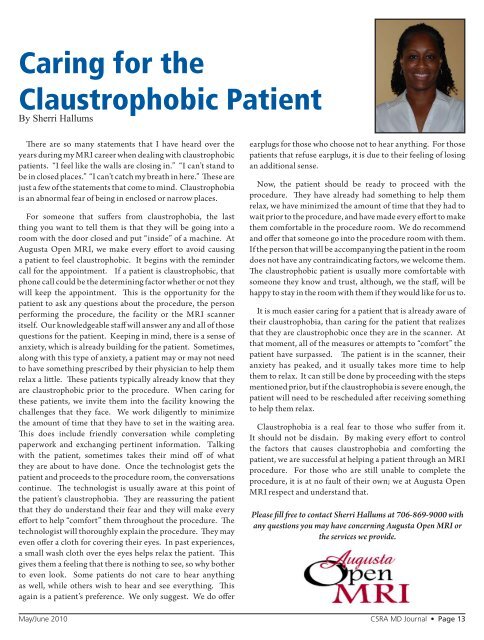Anna Kay Duckworth, MD - Savannah River Dermatology, LLC
Anna Kay Duckworth, MD - Savannah River Dermatology, LLC
Anna Kay Duckworth, MD - Savannah River Dermatology, LLC
- No tags were found...
Create successful ePaper yourself
Turn your PDF publications into a flip-book with our unique Google optimized e-Paper software.
Caring for theClaustrophobic PatientBy Sherri HallumsThere are so many statements that I have heard over theyears during my MRI career when dealing with claustrophobicpatients. “I feel like the walls are closing in.” “I can’t stand tobe in closed places.” “I can’t catch my breath in here.” These arejust a few of the statements that come to mind. Claustrophobiais an abnormal fear of being in enclosed or narrow places.For someone that suffers from claustrophobia, the lastthing you want to tell them is that they will be going into aroom with the door closed and put “inside” of a machine. AtAugusta Open MRI, we make every effort to avoid causinga patient to feel claustrophobic. It begins with the remindercall for the appointment. If a patient is claustrophobic, thatphone call could be the determining factor whether or not theywill keep the appointment. This is the opportunity for thepatient to ask any questions about the procedure, the personperforming the procedure, the facility or the MRI scanneritself. Our knowledgeable staff will answer any and all of thosequestions for the patient. Keeping in mind, there is a sense ofanxiety, which is already building for the patient. Sometimes,along with this type of anxiety, a patient may or may not needto have something prescribed by their physician to help themrelax a little. These patients typically already know that theyare claustrophobic prior to the procedure. When caring forthese patients, we invite them into the facility knowing thechallenges that they face. We work diligently to minimizethe amount of time that they have to set in the waiting area.This does include friendly conversation while completingpaperwork and exchanging pertinent information. Talkingwith the patient, sometimes takes their mind off of whatthey are about to have done. Once the technologist gets thepatient and proceeds to the procedure room, the conversationscontinue. The technologist is usually aware at this point ofthe patient’s claustrophobia. They are reassuring the patientthat they do understand their fear and they will make everyeffort to help “comfort” them throughout the procedure. Thetechnologist will thoroughly explain the procedure. They mayeven offer a cloth for covering their eyes. In past experiences,a small wash cloth over the eyes helps relax the patient. Thisgives them a feeling that there is nothing to see, so why botherto even look. Some patients do not care to hear anythingas well, while others wish to hear and see everything. Thisagain is a patient’s preference. We only suggest. We do offerearplugs for those who choose not to hear anything. For thosepatients that refuse earplugs, it is due to their feeling of losingan additional sense.Now, the patient should be ready to proceed with theprocedure. They have already had something to help themrelax, we have minimized the amount of time that they had towait prior to the procedure, and have made every effort to makethem comfortable in the procedure room. We do recommendand offer that someone go into the procedure room with them.If the person that will be accompanying the patient in the roomdoes not have any contraindicating factors, we welcome them.The claustrophobic patient is usually more comfortable withsomeone they know and trust, although, we the staff, will behappy to stay in the room with them if they would like for us to.It is much easier caring for a patient that is already aware oftheir claustrophobia, than caring for the patient that realizesthat they are claustrophobic once they are in the scanner. Atthat moment, all of the measures or attempts to “comfort” thepatient have surpassed. The patient is in the scanner, theiranxiety has peaked, and it usually takes more time to helpthem to relax. It can still be done by proceeding with the stepsmentioned prior, but if the claustrophobia is severe enough, thepatient will need to be rescheduled after receiving somethingto help them relax.Claustrophobia is a real fear to those who suffer from it.It should not be disdain. By making every effort to controlthe factors that causes claustrophobia and comforting thepatient, we are successful at helping a patient through an MRIprocedure. For those who are still unable to complete theprocedure, it is at no fault of their own; we at Augusta OpenMRI respect and understand that.Please fill free to contact Sherri Hallums at 706-869-9000 withany questions you may have concerning Augusta Open MRI orthe services we provide.May/June 2010 CSRA <strong>MD</strong> Journal • Page 13


